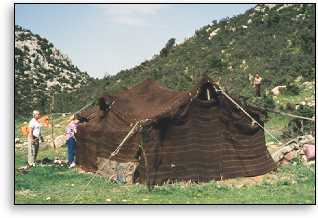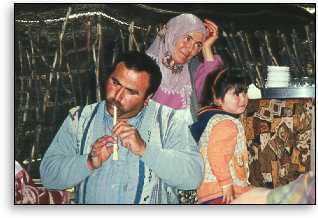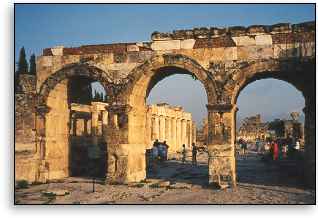Antalya to Hieropolis and Pamukkale, with a stop at a nomad's tent
Western Turkey - Group Journal
Day 10 -
Monday, 13 April 1998
by Martha Crunkleton
After breakfast at the Atelya Pensayan, we left the Mini Orient and the Atelya walked out of the old city to the bus, and left Antalya. A brief detour to the Archaeological Museum while Tim & Pat got new credit cards allowed us to walk through the gardens of the museum, strewn with ancient bric-a-brac (the museum itself was closed) and with lovely flowers (ice plant, geraniums, quince, verbena, thyme, wisteria, and hollyhocks.
Mahmut discussed the story of St. Nicholas and told us where his remains are buried in Demre. In Turkish, Saint Nicholas is Noel Baba; Nicholas was a Christian bishop of the 4th century who anonymously distributed gifts to dowry-less girls. His holiday is celebrated on January 6 with a special celebration in Demre (despite the fact that pirates from Bari, Italy have stolen many of his remains).
Meli discussed the rapid growth of Antalya and showed us the "pop up overnight" homes erected by immigrants from rural areas who move to the city to look for work and to make money. One family from a village may take up a plot on these public lands and cover quite a big area even if the house itself is small.
As the number geometrically increases, these people become potential voters. What politician will say, "We should knock these houses down?" Instead the politicians go to their houses and seek a quid pro quo for their votes. "You vote for our party - we will give you a deed even though we know what you did was illegal, etc." This leads to a cycle of building infrastructure (sewers, roads, schools, electricity) which is then followed by an onslaught of developers. In five years a person can go from a rural self-sufficient village life to a very modern urban life with a new Mercedes-Benz. These new dwellers, caught in a confusing flux of past, present and future, are vulnerable to drugs, fundamentalism and the exhortations of politicians. Rapid urbanization of this sort is occurring most dramatically in Istanbul, Izmir, Antalya, Adana, and Ankara.
By 10:15 a.m., we were in the countryside outside Antalya, driving through pine forests. We drive by Termessos, the only town in this area not conquered by Alexander the Great.
 At 11:00 we stopped at a nomad's tent to visit
a family with one small daughter at home and two grown children. The interior
of the tent was covered with carpets. The family has goats but the animals are
higher up the mountain, away from the road traffic. The family will stay at one
place for 3-4 years and then move - it depends on how much grazing land is
available for their animals.
At 11:00 we stopped at a nomad's tent to visit
a family with one small daughter at home and two grown children. The interior
of the tent was covered with carpets. The family has goats but the animals are
higher up the mountain, away from the road traffic. The family will stay at one
place for 3-4 years and then move - it depends on how much grazing land is
available for their animals.
The tent was made of black and dark brown home-spun wool and held together with sharpened twigs. The family has a propane gas stove and an automobile. A wooden fence of twigs, branches and cudgels tied with cord forms the lower half or superstructure of the tent. Five stout tree branches serve as the lodgepoles of the tent.
 We were served tea, with the
tiny charming daughter (just turned 4 and with henna on her hands to celebrate)
passing out the tea saucers. This family, like everyone we have visited in this
trip, treats us in the tradition of "God's guests." Their hospitality is
generous and warm. New nomads are becoming semi-nomadic, owning some farmland.
We examined a flute made of eagle bone.
We were served tea, with the
tiny charming daughter (just turned 4 and with henna on her hands to celebrate)
passing out the tea saucers. This family, like everyone we have visited in this
trip, treats us in the tradition of "God's guests." Their hospitality is
generous and warm. New nomads are becoming semi-nomadic, owning some farmland.
We examined a flute made of eagle bone.
Meli confessed she has butterfly phobia.
We resumed travel at 11:25 stopping again at 11:35 for a little snack and a wc break. The snack was unleavened bread dough with white cheese and parsley in it, cooked over an inverted brazier. Quite tasty! Many also used the break to purchase several kinds of Turkish delight, of which the shop had many varieties. The shop is owned by the family whose tent we visited. The family is very entrepreneurial with a strong work ethic.
We resumed travel at 12:05 p.m. Meli discussed the mid-tour evaluation and explained how the logistics of group travel necessitate compromises. She hopes we will return to Turkey (It sounds like some people used their evaluations to vent - I wonder what their expectations were!)
Children are back in school today after a long holiday for the Feast of Sacrifice. They wear uniforms with different colors for grammar, middle, and high school students. Mahmut told us the uniforms used to be black and white. He's glad the color scheme has changed to include red and white, blue and white, and navy and grey.
At 2:25 we had a great view of the Meander River Valley, an area so fertile it produces four crops in one year.
At 2:30 p.m. we went to a restaurant specializing in mushrooms in Bagbasi, the Mantar Restaurant. Lunch was delicious! Herewith the 3 recipes:
Mushrooms with tomatoes: In one tablespoon of olive oil, sauté 1 LB mushrooms, quartered (sauté until they become dry). Sauté in olive oil: 1 onion, chopped chopped tomatoes chopped Italian pepper Add the mushrooms, 1/2 tsp. cumin, salt and pepper. Mushrooms with yogurt: Cook mushrooms as above, add chopped garlic, turn off stove and add red pepper. Serve with yogurt. Mushrooms baked with Cheese: In an earthenware plate, place larger mushrooms covered with Cushar cheese (a cross between mozzarella and gruyere) and bake uncovered until cheese browns.
We drove by the statue of the rooster in Denizli, a fast growing city, known for weaving. Meli described the behavior of the nouveau riche in Denizli and the citizens desire to genetically engineer a rooster that could crow longer than any other in the world. Chamber of Commerce boosterism is not limited to the U.S. with cities vying to build larger and larger sports stadia! This curious obsession of the Denizli citizens had led to three immense statues and many pictures of roosters all over the city. Meli told us the Greek myth of the origin of the rooster (Apreo - Hephrastos - Aphrodite).
 At 3:50 we checked into Yoruk Hotel, and at
5:00 p.m. boarded the bus for Pamukkale to walk in the pools. Pamukkale
means "cotton fortress."
At 3:50 we checked into Yoruk Hotel, and at
5:00 p.m. boarded the bus for Pamukkale to walk in the pools. Pamukkale
means "cotton fortress."
Hieropolis is the largest necropolis excavated that was active between early Hellenistic period and early Christianty. Grave diggers came to Hieropolios before the archaeologists arrived, robbing many of the graves. The necropolis is right by the city (this was anomalous for the famous). The beautiful Roman theatre seats 12,000. Romans came to this beautiful place to die. We returned to our hotel for dinner.